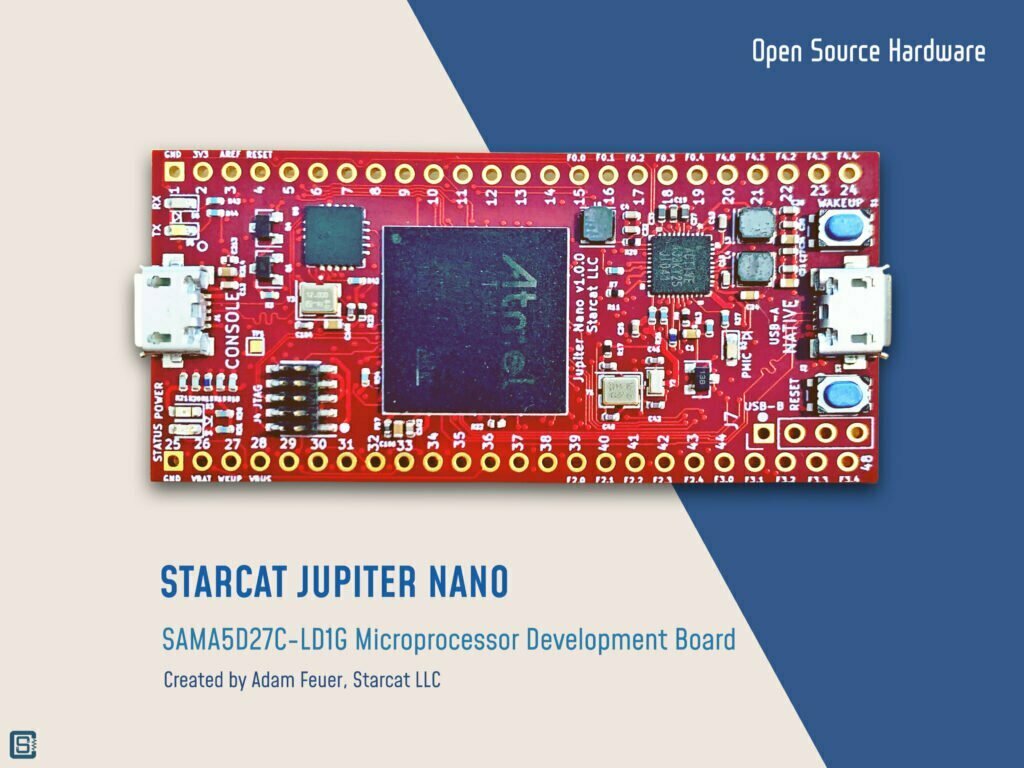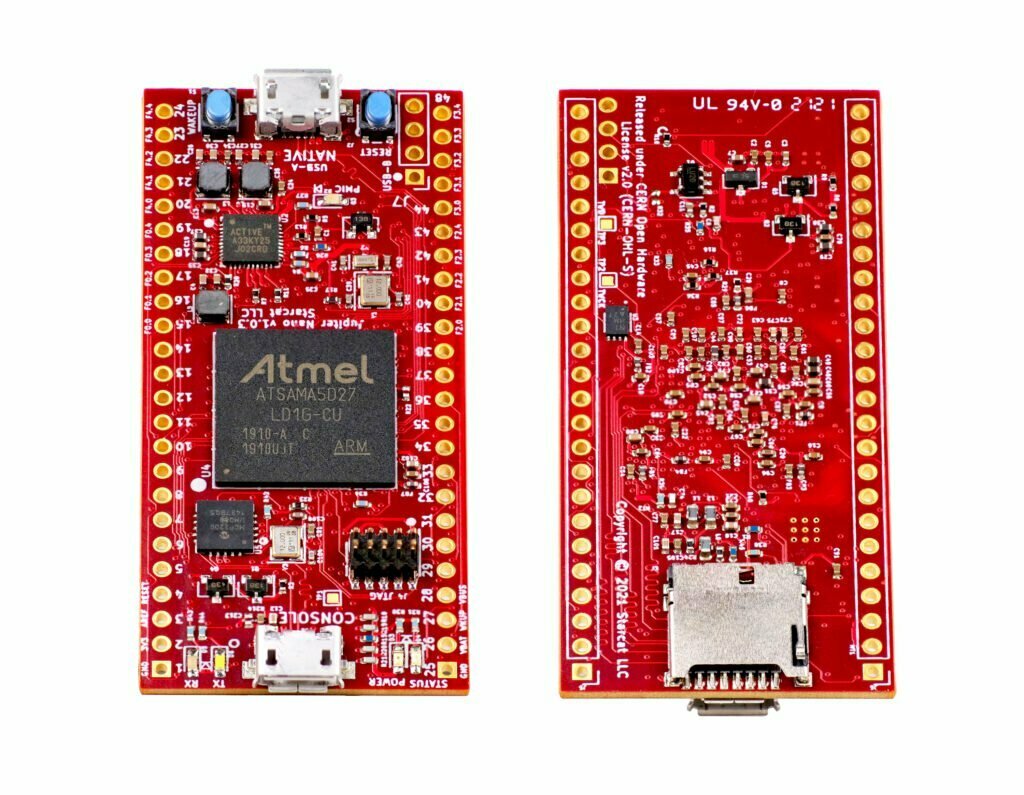Starcat Jupiter Nano – Compact and High Performance Embedded Microprocessor Board that Runs Linux
Have you ever ran into a situation where your design needed a little more RAM, a little more Flash or a little more clockspeed? While there is an obvious “price” to pay for performance, which one would you choose if you wanted to? Well, Jupiter Nano designed by Adam Feuer from Starcat LLC can be a good choice. It is a fully open source embedded microprocessor (something that sits between a microcontroller and a modern general purpose CPU) development board based on Microchip’s ATSAMA5D27C-LD1G high-performance MPU in a BGA361 package. The low-power microprocessor has a single Arm Cortex-A5 core at its heart. It can be clocked up to 500MHz and features up to 1Gbit (128MB) integrated LPDDR2 SDRAM. The BGA361 package supports up to 128 IO lines and a broad set of hardware peripherals including multiple UART, QSPI, I2C, CAN, USB and Ethernet among others. All of these make it possible for Jupiter Nano to run a version of Linux, NuttX RTOS or MicroPython (through Linux). If you want to get your hands on one, it is soon launching at Crowd Supply. Subscribe to get notified when it goes live.
Jupiter Nano Features and Specifications
- Open Source Hardware development board designed in KiCad
- Runs NuttX RTOS, Linux, or MicroPython (on Linux)
- Tiny 48-pin form factor (1.125″ x 2.5″, similar in size to Teensy 4.1)
- 10x more powerful than the Arduino Due
- ARM Cortex A5 processor running at 498Mhz (7x clock speed of the Arduino Due)
- 128MB RAM (1280x RAM of Arduino Due)
- Key peripherals use DMA (USB, SPI, I2C, Flexcom)
- CPU: Microchip SAMA5D27C-LD1G running at 498Mhz
- DRAM: AP Memory AD2100XXX 128Mx32 LPDDR2 DRAM chip integrated into system-in-package (SIP)
- Power management: Quorvo ACT8945 with integrated LiPo battery charging capability
- Compatible with many LiPo batteries
- I/O Features
- USB 2.0 HS port on USB-micro B jack (Port A, 480Mbps, host or device)
- USB 2.0 HS port on a pin-header connection (Port B, 480 Mbps, host only)
- USB 2.0 FS Debug console port on USB-micro B jack (12Mbps)
- SD Card slot – 50MHz DDR (the board boots from this, so it is impossible to brick the device)
- Native SPI and I2C ports
- 4 FLEXCOMs on I/O pins – flexible serial controller peripherals that can be SPI, UART, or I2C
- 40 total PIO pins available for I/O, 48 pin PCB
- JTAG port for programming and debugging
Microchip SAMA5D27C-LD1G Specifications
- Part Family: SAMA5D2
- Core: Cortex-A5
- FPU: Yes
- ARM Neon: Yes
- Arm Trust Zone®: Yes
- Max CPU Speed: 500 MHz
- Core Voltage Range: 1.1 to 1.32V
- Vbat/Vddbu battery backup: Yes
- Internal Oscillator: 32kHz, 12MHz
- SRAM: 128KB
- L1 Cache Memory (Instructions): 32 KB
- L1 Cache Memory (Data): 32 KB
- L2 Cache Memory: 128KB
- DRAM Bus Size: 32 Bits
- Internal DRAM Type: LPDDR2
- Internal DRAM Amount: 128MB
- NAND Interface: Yes
- ECC Bits on NAND Interface: 32
- Number of EBIs: 1
- SDIO/SD-CARD/eMMC: 2
- QSPI: 2
- Direct Memory Access Channels: 51
- Max I/O Pins: 128
- Pincount: 361
- UART: 10
- ISO 7816: 10
- SPI: 7
- I2C: 7
- SSC: 2
- CAN: 2
- Type of CAN Module: CAN
- LIN: Yes
- USB Device and Host Ports: 1 HS
- USB Host Only Ports: 1 HS & 1 HSIC
- 10/100 Ethernet MAC: 1
- Ethernet PTP & AVB Support: Ethernet PTP
- Graphics Controller/GPU: Yes
- Graphic LCD: 24-bit
- Hardware Touch Peripheral: PTC
- Camera Interface: Yes
- Integrity Check Monitor (ICM): Yes
- Secure Bootloader: Yes
- Crypto Engine: Yes
- External Memory Encrypt/Decrypt: Yes
- Anti-Tamper Pins: 8
- Secure Key Storage (Fuse bits): 544
- ADC Input: 12
- Max ADC Resolution (bits): 12
- Max ADC Sampling Rate: 1000 ksps
- Temp Sensor: Yes
- Hardware RTCC/RTC: Yes
- Watch Dog Timer: Yes
- Max 16-Bit Digital Timers: 4
- Max 32-Bit Digital Timers: 6
- Input Capture: 6
- Standalone Output Compare/Standard PWM: 6
- Quadrature Encoder Interface: 2
- Temperature Range: -40 to 85 °C
Even though Nano doesn’t breakout all the pins of the SAMA5D2, you still get plenty of IO options from the 48 pin PCB. Jupiter Nano has two micro USBs supporting High Speed USB 2.0 with speeds up to 35MBps. One is for the native USB interface and the other one for serial debugging. The native interface can be used for Ethernet-over-USB, making things easy for internet/network connected applications. An extra native HS USB is available as breakout header. MCP2200 is used as a UART-USB bridge for serial debugging. Qorvo’s ACT8945A power management IC (PMIC) is present on the PCB for generating the low operating voltages and charging Li-Ion batteries. This is useful when you want to make your application portable. Well thought design indeed.
There are multiple LEDs for all status indications. Unlike microcontrollers, SAMA5D2 MPU does not have integrated flash memory. Instructions have to be loaded from an external memory such as SD cards. This gives you an almost limitless amount of program storage. A micro SD card interface with 50MHz DDR (50Mbps) is available on Jupiter Nano for this purpose. The DMA takes care of most the heavy moving of data while a standard 10-pin JTAG header can be used for programming and debugging.
Story of Jupiter Nano
Adam Feuer is an electronics engineer and entrepreneur from Seattle, WA, USA. He founded Starcat LLC, a company that primarily builds open source hardware. HackEEG shield for Arduino Due was their first release and it was a huge success. It produces research-grade EEG data and is used by many major universities and research institutes around the world, including Sandford University and Hardward Medical School. Processing the data coming from Texas Instuments ADS1299 24-bit simultaneous sampling ADC requires some good hardware. Arduino Due, being ARM based, was a good choice for this. But Adam is working on newer applications that require even more computing power. That’s when he decided to create a new hardware platform based on SAMA5D2, and Jupiter Nano was born. This also indicates that we can soon expect a newer version of HackEEG that uses Jupiter Nano instead of Due. The new EEG hardware will be named MI32 according to Adam.
The Jupiter Nano project is fully open source. The PCB was designed in open source EDA program KiCad. Once the project goes live on Crowd Supply, you will be able to download all the design files and obtain proper documentation and getting started tutorials. The board will cost around USD 80 and we can expect a release by the end of this month, according to Adam. Jupiter Nano is part of the Microchip Get Launched design program at Crowd Supply.
Links
- Jupiter Nano – Crowd Supply
- Jupiter Nano – KiCad Hardware Design Files
- Jupiter Nano – Software Tools
- Starcat LLC Website
- Adam Feuer – GitHub
- Starcat – Twitter
- Microchip ATSAMA5D27C-LD1G – Product Page
- Quorvo ACT8945 PMIC – Product Page
- Microchip MCP2200 USB-Serial Bridge – Product Page
- Texas Instruments ADS1299 24-bit ADC – Product Page
- HackEEG shield for Arduino Due
- NuttX RTOS
- MicroPython
Short Link
- Short URL to this page – https://circuitstate.com/scjnano








